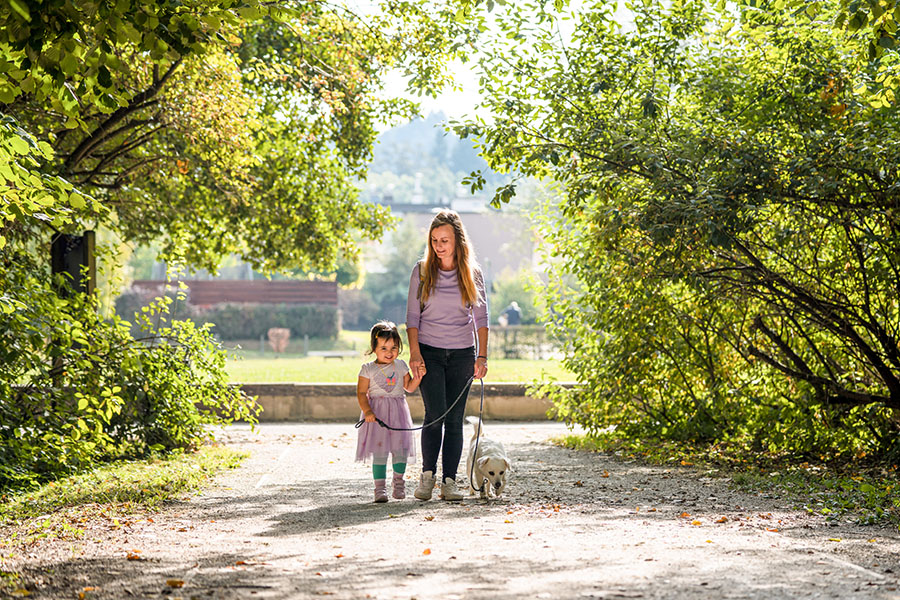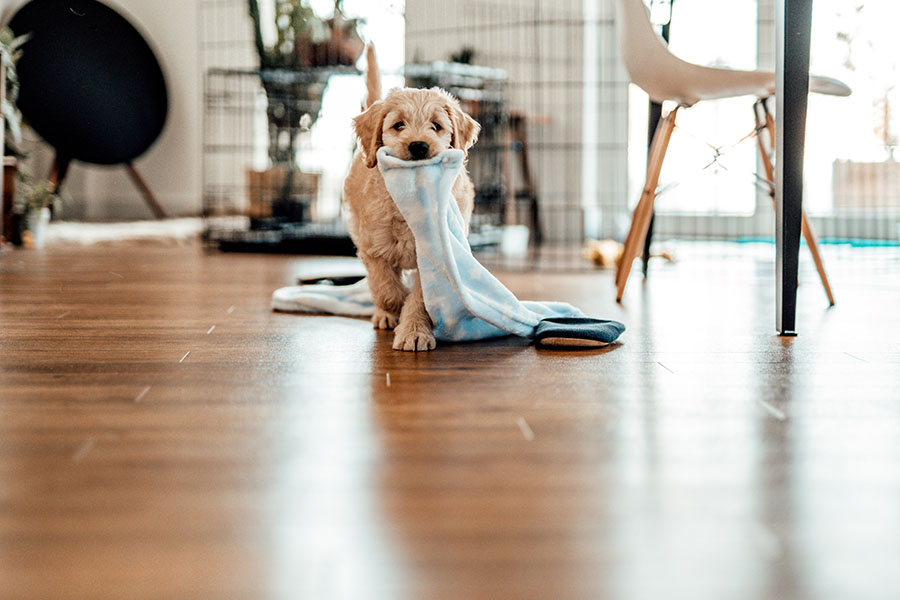An agent explains what buyers with dogs or cats are looking for (and what they aren’t).

Some people choose a home because it’s adjacent to a hopping entertainment district or close to their job. But those of us with dogs, cats and other animals that are like our children, we pick homes that will make our pets happy. A 2022 Zillow survey found that 61% of dog owners would consider moving to a new home if it was better suited for their pup. Here are nine pet-approved tips for finding a home.
1. Look for a property with a fenced-in yard
The holy grail for dog-owning homebuyers is a bucolic, grassy yard where your dog can play behind a secure fence. Zillow research found that 73% of buyers with pets said a home with private outdoor space was very or extremely important. Look for a physical fence, not an invisible one, says Nicole Prince, an agent with the Figueroa Team in Orlando.
Prince says invisible fences (also called e-fences) have fallen out of favor. “None of my buyers with dogs want to put a shock collar on their dog,” Prince says. “They want to buy a house with an actual fence.”
The next best thing to a fully fenced yard is a partially fenced one, Prince says. You can expand the fence to give your fur kid a safe outdoor place to play.
2. If the house has a pool, make sure the pool is pet safe
A pet-safe pool has a fence that separates the pool from the rest of the yard. A pool fence is a safety feature that helps prevent kids and pets from falling into the pool while unsupervised. Many cities and towns require fences around pools, but not all do. Even if your dog can swim, a fall into the pool while you are not home could be life-threatening or even fatal to your dog.
Sure, a Lab isn’t a drowning risk, but not all dogs can swim. Some breeds, like Basset Hounds, Pugs or Dachshunds, are not physically built to dog paddle. They have short legs, barrel-shaped bodies or flat faces that make swimming and breathing tough. The Pool Safety Network says thousands of dogs die in pools in their yard each year.
3. Pick a neighborhood with dog-friendly amenities
Look for a dog park within walking distance and restaurants and cafes that welcome dogs on their patio. Sidewalks, greenways, pet-friendly city parks and pet watering stations are nice features, too. Look for an area with services your pet will need, as well. “I’ve had clients ask me if I knew a dog walker and if there was a doggy daycare near a house,” Prince says. She’s also helped dog-owning home buyers find properties close to a highly rated veterinarian or dog groomer.

4. Beware of stairs
Dogs and stairs don’t always mix. Whether you’re looking at a two-story home with one flight of stairs or a condo that can only be accessed by several flights of stairs, those steps can be a barrier for a dog. “Stairs can be a real obstacle, especially if you have a short or an old dog,” Prince says. Stairs could limit your dog’s mobility within your house. She recommends looking for single-story houses on a slab or condos with elevators your dog can ride in.
5. Find a house with a bedroom on the first floor
Beware of stairs, part two. If you let your pet sleep in bed with you and your bedroom is up a flight of stairs and your dog is old or short-legged, you may not be able to get your fur baby to bed. Prince recommends you look for a house with a bedroom on the main floor. “Even if your dog is young and has no problems scaling the stairs now, the time will come when he’ll struggle with them,” Prince says. She advises choosing a house that will let your pet age in place. If your dog is a Basset Hound, Dachshund or Corgi, they will thank you for removing the stairs between them and your bed.
6. Buy a house without carpet
Accidents happen, even with house-trained pets, so floors with a hard, impermeable surface are your friend. “Carpets soak up stains, so they’re a big no-no,” Prince says. She advises homebuyers with pets to look for hardwood, tile or laminate floors. And here’s a pro tip from Prince: “If you can get floors that match the color of your dog’s fur, you can camouflage the dog hair they shed. I have brown laminate floors that are the same color as my dog’s fur. It’s my alternative to running a Roomba 24/7.”

7. Buy a larger home
Pets need room to roam inside, so you might feel crowded if you and your pups and kitties are stuffed into a 1,000-square-foot house. Prince says her buyers with pets are generally looking for larger homes. “Most of them want at least three bedrooms because they usually have several pets,” she says. A Zillow survey found that buyers with pets were nearly twice as likely as buyers without pets to buy homes larger than 3,000 square feet. The spacious homes weren’t just for pets. The same survey found that pet-owning buyers were more likely to have human children in their homes as well, so they needed the space.
8. Make sure the home isn’t near dangerous wildlife
Depending on where you live, you may need to avoid properties adjacent to wilderness areas inhabited by wild animals that could harm your pet. In the Southwest, this means staying away from desert expanses where there’s the risk that rattlesnakes bite your dog. Home shopping in the Southeast or Pacific Northwest? This may mean staying away from homes by forests where birds of prey could snatch a small dog or cat out of the yard. In Florida, where Prince sells homes, this means avoiding homes on lakes and ponds where alligators lurk. “A lot of my buyers don’t want a home near a body of fresh water,” Prince says. “The odds of your dog or cat getting taken by a gator are slim, but it happens here.” Your best bet is a dense, urban neighborhood that doesn’t back up to an area where the wild things are.
9. Beware of properties subject to breed or weight restrictions
Some HOAs, neighborhood covenants or co-op boards restrict the type, number and size of animals they allow. Before you buy, make sure a property isn’t subject to rules that will limit the breed, size or number of dogs you can have. Prince says she’s seen neighborhood associations and property management boards that forbid homeowners to have so-called “dangerous breeds” like Pitbulls, German Shepherds, Malamutes, Chow Chows and Mastiffs. She’s also encountered property management associations in townhome or condo communities that have weight limits for pets or limit homeowners to two dogs. If you plan to increase the pets in your family, steer clear of properties that may keep you from adding to your pack
Tip: Let your agent know right away about your pets. Share any concerns you have so that your agent can apply them to your home search.

